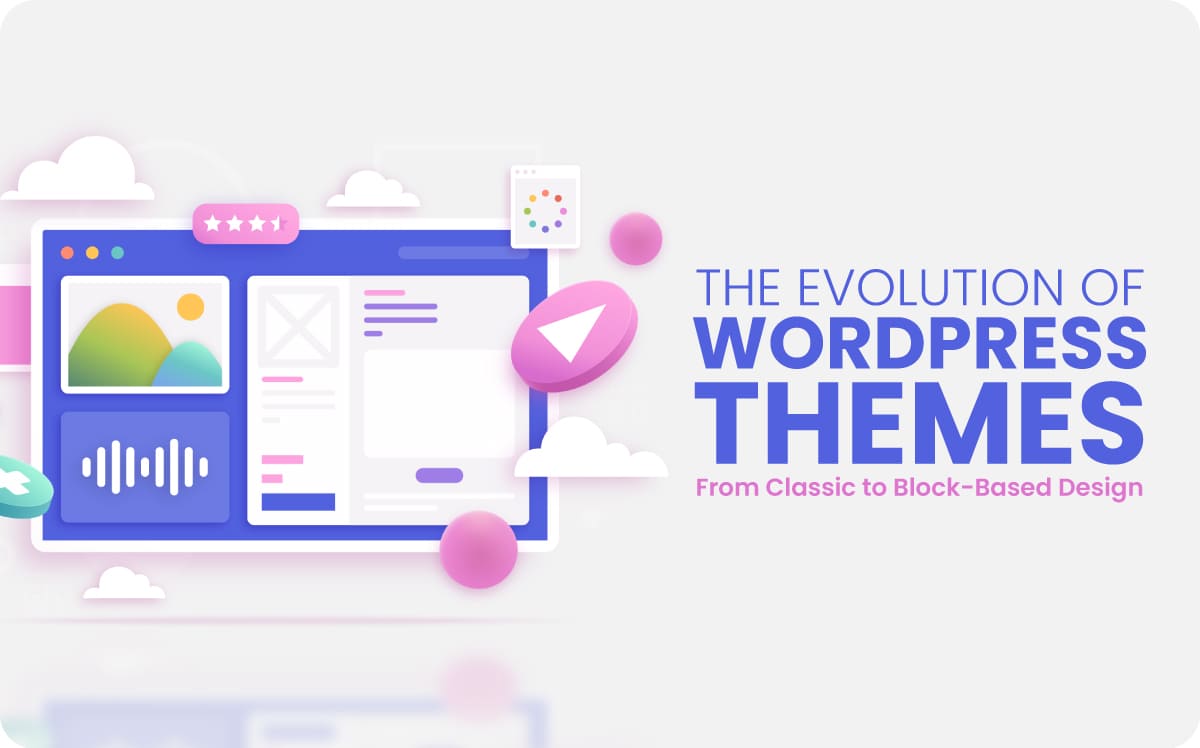Over the years, WordPress theming has seen a dramatic shift, moving from the conventional classic themes to the more modern, block-based designs that now dominate the platform. This change has not only redefined how websites are constructed and styled but has also transformed the way users engage with WordPress as a content management system.
Today, we’re going to walk through the evolution of WordPress themes, how they changed and which one you should go for.
The Era of Classic Themes
For a long time, classic WordPress themes were the cornerstone of the platform. It was the main thing that made it easier to build a website if you didn’t have any technical knowledge. These themes were built on a framework of PHP files and depended largely on the WordPress Customizer for making design and layout adjustments. The structure of classic themes followed a hierarchical template system, where different PHP files determined the layout and functionality of multiple sections of a site. For instance, the index.php file served as the main template, while other files like single.php and archive.php were used to manage specific content types.
However, as customizing classic themes often required users to engage directly with code, it made making significant changes a more technical process. What’s more, while plugins and custom CSS offered some flexibility, the overall experience was rooted in a more static and less interactive environment.
Welcoming Block-Based Design
The introduction of the Gutenberg block editor in WordPress 5.0 marked a pivotal change in theming. It was the end of an era with classic designs, paving the way for a more creative path. This new editor brought a modular approach to content creation, allowing users to build pages and posts by assembling individual blocks that could be easily customized and rearranged. This was a notable departure from the classic editor, which operated on a more linear content input method.
As WordPress grew, with the release of its 5.9 version, block-based themes, also known as Full Site Editing (FSE) themes, became a reality. These themes are entirely block-driven, meaning every aspect of a website – from the header to the footer- can be edited directly within the WordPress Site Editor. This block-based approach offers unparalleled flexibility and design control, empowering users to create complex layouts without needing to write a single line of code. Talk about an upgrade!
What are the Other Differences Between Classic and Block-Based Themes?
Besides the fact that users can now create and design websites from scratch without needing to write code, one of the most striking differences between classic and block-based themes lies in how they handle design and customization. In classic themes, the WordPress Customizer was the go-to tool for altering the site’s appearance. However, block-based themes have done away with the Customizer, replacing it with the Site Editor, where users can manipulate blocks to build and style their websites.
Another crucial difference is the introduction of the theme.json file in block-based themes. This file allows developers to set global styles and settings for the entire theme, such as typography, color schemes, and spacing. This centralized approach to styling contrasts sharply with the more fragmented and code-heavy methods used in classic themes.
Imagine building a house: In the old way of building houses (classic WordPress), you’d pick out all the colors, styles, and sizes for each room separately. But now, there’s a new way to build houses (block-based WordPress), where you have a big book of rules for the whole house, and it tells you what colors to use, how big the rooms should be, and what kind of furniture goes where. It’s much easier and faster to build a house this way, because you don’t have to make a million tiny decisions. That’s what the “theme.json” file is like. It’s the big book of rules for the whole website.
What About Hybrid Themes?
WordPress keeps evolving and figuring out ways to make creating a website fun, easy and stress-free. Recently, the content management system has introduced hybrid themes. These have surfaced as a bridge between classic and block-based designs. What they do is combine traditional PHP templates with modern block-based features like theme.json and block templates. This approach offers a smoother transition for users and developers who are not yet ready to fully commit to block-based theming.
As a result, hybrid themes are the go-to resource for websites that were originally built using classic themes but want to tap into the flexibility and customization options provided by block-based themes. These themes make it possible to gradually update and enhance a site by incorporating block-based elements such as customizable headers, footers, and content blocks, all while preserving the core structure and functionality of the existing classic theme. You are essentially modernizing your website’s design and features without needing to overhaul everything at once.
The Future of WordPress Theming
The evolution from classic to block-based themes is part of a broader trend in web design toward more user-friendly and flexible systems. You cannot hope that everyone is a tech-savvy code-master and can build a website from scratch! So, you have to create a platform that caters to every users’ knowledge. Therefore, as block-based theming continues to mature and tools like AI start integrating with WordPress, the gap between professional developers and everyday users will likely continue to narrow.
This progression in building websites has significantly altered the way they are built and managed. While classic themes provide a robust foundation, block-based themes offer a vision of the future of web design, where creativity and customization know no bounds. We could not be more excited to see what users will be able to create now that they have the tools to further enhance their ability to create stunning, dynamic websites.
